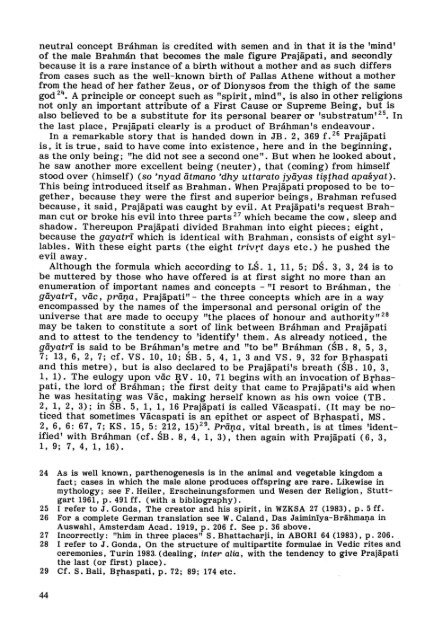Prajapati's relations with Brahman, Brhaspati and Brahma - DWC
Prajapati's relations with Brahman, Brhaspati and Brahma - DWC
Prajapati's relations with Brahman, Brhaspati and Brahma - DWC
Create successful ePaper yourself
Turn your PDF publications into a flip-book with our unique Google optimized e-Paper software.
neutral concept Bráhman is credited <strong>with</strong> semen <strong>and</strong> in that it is the 'mind'<br />
of the male Brahmán that becomes the male figure Prajäpati. <strong>and</strong> secondly<br />
because it is a rare instanee of a birth <strong>with</strong>out a mother <strong>and</strong> as such differs<br />
from cases such as the well-known birth of Pallas Athene <strong>with</strong>out a mother<br />
from the head of her father Zeus, or of Dionysos from the thigh of the same<br />
god 24. A principle or concept such as "spirit, mind". is also in other religions<br />
not only an important attribute of a First Cause or Supreme Being. but is<br />
also believed to. be a substitute for its personal bearer or 'sub stratum ,25. In<br />
the last place, Prajäpati clearly is a product of Bráhman 's endeavour.<br />
In a remarkable story that is h<strong>and</strong>ed down in JB. 2, 369 f. 26 Prajäpati<br />
is, it is true, said to have come into existence, here <strong>and</strong> in the beginning ,<br />
as the only being; "he did not see a second one". But when he looked about,<br />
he sawanother more excellent being (neuter) , that (coming) from himself<br />
stood over (himself) (so 'nyad ätmano 'dhy uttarato jyäyas ti~thad apasyat).<br />
This being introduced itself as <strong><strong>Brahma</strong>n</strong>. When Prajäpati proposed to be together,<br />
because they were the first <strong>and</strong> superior beings, <strong><strong>Brahma</strong>n</strong> refused<br />
because, it said, Prajäpati was caught byevil. At Prajäpati's request <strong><strong>Brahma</strong>n</strong><br />
cut or broke his evil into three parts 27 which became the cow, sleep <strong>and</strong><br />
shadow. Thereupon Prajäpati divided <strong><strong>Brahma</strong>n</strong> into eight pieces; eight,<br />
because the gayatrf which is identical <strong>with</strong> <strong><strong>Brahma</strong>n</strong>, consists of eight syllables<br />
. With these eight parts (the eight trivrt days etc.) he pushed the<br />
evil away.<br />
Although the formula which according to LS. 1, 11, 5; DS. 3, 3, 24 is to<br />
be muttered by those who have offered is at first sight no more than an<br />
enumeration of important names <strong>and</strong> concepts - "I resort to Bráhman, the<br />
gäyatrf, väc, prä~a, Prajäpati" - the three concepts which are in a way<br />
encompassed by the names of the impersonal <strong>and</strong> personal origin of the<br />
universe that are made to occupy "the places of honour <strong>and</strong> authority" 28<br />
may be taken to constitute a sort of link bet ween Bráhman <strong>and</strong> Prajäpati<br />
<strong>and</strong> to attest to the tendency to 'identify' them. As already noticed, the<br />
gäyatrf is said to be Bráhman's metre <strong>and</strong> "to be" Bráhman (SB. 8, 5, 3,<br />
7; 13,6,2,7; cf. VS. 10, 10; SB. 5,4,1,3 <strong>and</strong> VS. 9,32 for ~rhaspati<br />
<strong>and</strong> this metre) , but is also declared to be Prajäpati's breath (SB. 10, 3,<br />
1, ~). The eulogy upon väc ~V. 10, 71 begins <strong>with</strong> an invocation of Brhaspab,<br />
the lord of Bráhman; the first deity that came to Prajäpati's aid when<br />
he was hesitatÎl)g was Väc, making herself known as his own voice (TB.<br />
2, 1, 2, 3); in SB. 5, 1, 1, 16 Prajäpati is called Väcaspati. (It may be noticed<br />
that sometimes Väcaspati is an epithet or aspect of <strong>Brhaspati</strong>, MS.<br />
2, 6, 6: 67, 7; KS. 15, 5: 212, 15)29. Präna, vital breath, is at times 'identified'<br />
<strong>with</strong> Bráhman (cf. SB. 8, 4, 1, 3): then again <strong>with</strong> Prajäpati (6, 3,<br />
1,9; 7,4,1,16).<br />
24 As is wen known, parthenogenesis is in the animal <strong>and</strong> vegetable kingdom a<br />
fact; cases in which the male alone produces offspring are rare. Likewise in<br />
mythology; see F. Heiler, Erscheinungsformen und Wesen der Religion, Stuttgart<br />
1961, p. 491ff. (<strong>with</strong> a bibliography).<br />
25 I refer to J. Gonda, The creator <strong>and</strong> his spirit, in WZKSA 27 (1983), p. 5 ff.<br />
26 For a complete German translation see W. Cal<strong>and</strong>, Das Jaiminïya-BrähmaI}a in<br />
Auswahl, Amsterdam Acad. 1919, p. 206 f. See p. 36 above.<br />
27 Incorrectly: "him in three places" S. Bhattacharji, in ABORI 64 (1983), p. 206.<br />
28 I refer to J. Gonda, On the structure of multipartite formulaé in Vedic rites <strong>and</strong><br />
ceremonies, Turin 1983. (dealing, inter aHa, <strong>with</strong> the tendency to give Prajäpati<br />
the last (or first) place).<br />
29 Cf. S. Bali, <strong>Brhaspati</strong>, p. 72; 89; 174 etc.<br />
44
















